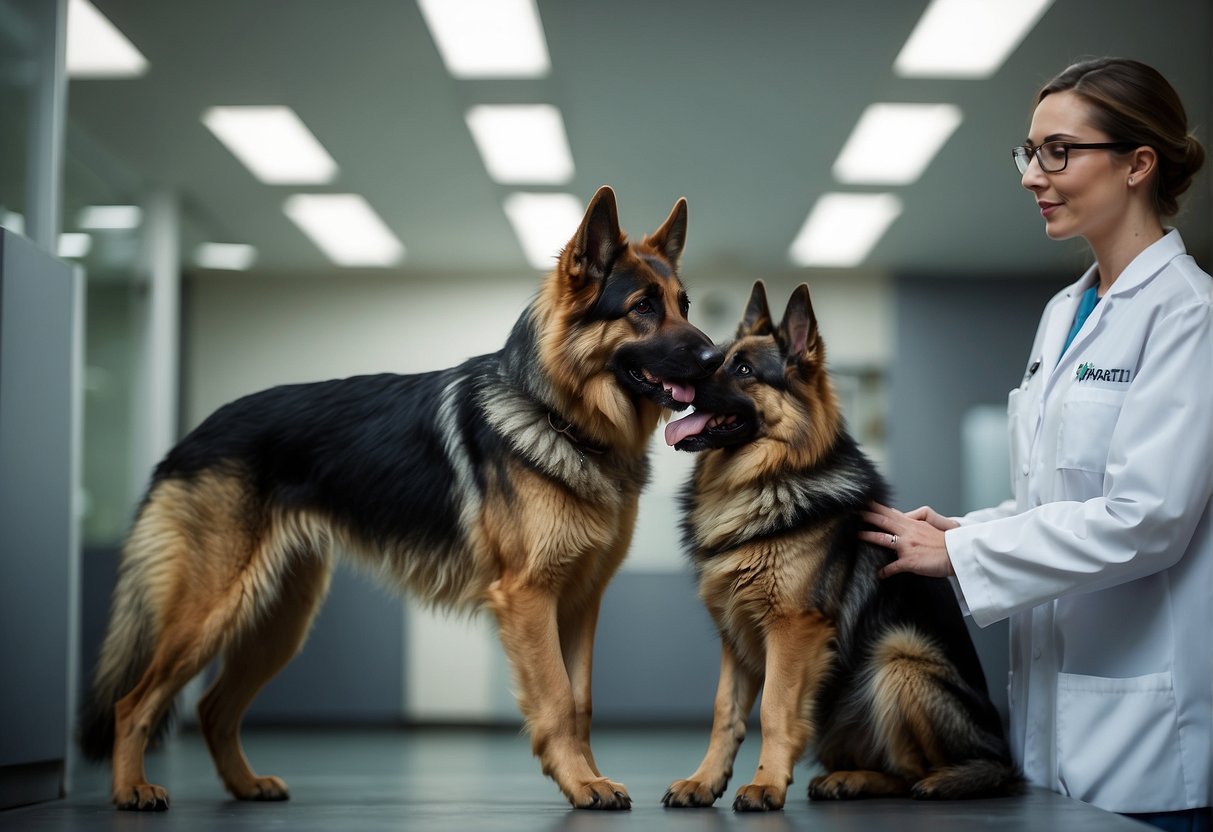Breeding German Shepherds is a commitment that comes with great responsibility. As an aspiring breeder, you should have a deep understanding of what breeding entails to ensure the well-being of your dogs and to contribute positively to the breed’s future.
Knowledge about the breed’s history, characteristics, and health concerns is essential before embarking on the breeding journey and a successful breeding program.
Before you get started, remember that breeding German Shepherds requires thorough preparation and consideration. It is not just about choosing two purebred dogs; it involves evaluating their health, temperament, and lineage to maintain breed standards and promote the health of future generations.
You’ll need to be familiar with the entire breeding process, from selecting the sire and dam to caring for the pregnant mother and raising the puppies.
Key Takeaways
- Breeding German Shepherds should be approached with a comprehensive understanding of the breed.
- Preparing to breed involves health, temperament, and lineage evaluations of the sire and dam.
- Provide dedicated care throughout the breeding process, pregnancy, and puppy rearing.

Understanding the German Shepherd Breed
When you’re considering breeding German Shepherds, it’s vital to have a firm understanding of their rich heritage and the specific breed standards that define them.
These dogs are known not just for their versatility as working dogs but also for their loyal and intelligent temperament.
History and Origin
German Shepherds, as the name implies, originated in Germany towards the end of the 19th century. Max von Stephanitz, an ex-cavalry captain and former student of the Berlin Veterinary College, is credited with the breed’s creation.
Recognizing the need for a superior German working dog, Stephanitz found a dog named Hektor Linksrhein, later renamed Horand von Grafrath, whom he deemed the perfect standard for the breed.
Horand became the first German Shepherd Dog registered by the newly formed Verein für Deutsche Schäferhunde, the society Stephanitz established.
Breed Standard and Characteristics
The Breed standards, as recognized by the American Kennel Club, describe the ideal German Shepherd as a strong, agile dog, more lengthy than tall, with a noble character. The characteristics that define them include:
- General Appearance: A balanced, muscular dog with a confident and noble demeanor.
- Size: Males should stand 24 to 26 inches tall at the shoulder, while females should stand 22 to 24 inches.
- Coat: Typically dense with a straight, harsh outer coat and softer undercoat.
- Color: Most commonly tan with black saddle, but also sable, all black, and all white.
- Temperament: Known for their courage, they are watchful, alert, loyal, and intelligent.
- Ability: Excel in various roles, from service dogs to herding and search-and-rescue.
The temperament of a German Shepherd is as important as its physical attributes.
As a potential breeder, your aim is to maintain these breed standards, ensuring the dogs you breed have the qualities that make German Shepherds such esteemed working dogs.
Balancing the nurturing of both their mental and physical traits is your key responsibility.
Pre-Breeding Considerations

Before you embark on breeding German Shepherds, ensure you’ve laid a solid foundation for a responsible breeding program.
Pay close attention to detailed health screenings and selecting compatible mates to promote the breed’s well-being.
Health and Genetic Screening
Your German Shepherd’s health is the cornerstone of successful breeding. First, consult with a vet to conduct a comprehensive health screening.
The Orthopedic Foundation for Animals (OFA) provides health clearances for conditions such as hip dysplasia and elbow dysplasia, both of which are common in the breed.
It’s also wise to conduct a thyroid panel and test for other genetic disorders prevalent within the breed. This ensures that the dogs you intend to breed are healthy and fit for producing offspring.
- Checklist for Health Screening:
- OFA certification for hips and elbows
- Thyroid panel test
- Genetic tests for breed-specific heritable diseases
Choosing the Right Mate
Selecting the right mate for your German Shepherd involves more than just picking another dog with a pedigree. Look for a partner whose traits complement and enhance your dog’s qualities.
Factors like temperament, lineage, and physical attributes should all be considered. Your goal is to find a mate that not only meets breed standards but also helps minimize the risk of transmitting any congenital health issues to their progeny.
- Tips for Mate Selection:
- Ensure the potential mate has similar health clearances.
- Consider the temperament and lineage of the breeding partner.
- Aim for a mate that compensates for your dog’s weaker traits.
Please note that the appropriate breeding age for German Shepherds is another crucial consideration, as breeding too young can pose health risks to both the dam and the future puppies.
The Breeding Process
When you decide to breed your German Shepherd, it’s essential to understand the heat cycle and the steps for successful mating and conception. Proper knowledge ensures responsible breeding and the health of both the dam and future puppies.

Understanding the German Shepherd Heat Cycle
Your German Shepherd female will experience her first heat cycle, typically around 6 to 12 months of age, though waiting until they are fertile and mature—at least 2 years old—is recommended for breeding.
The heat cycle occurs every six months and includes four stages:
- Proestrus: Lasting approximately nine days, this is when your dog begins to attract males but isn’t yet ready to mate.
- Estrus: This is the fertile phase when ovulation occurs—lasting 3 to 11 days—and the perfect time for breeding.
- Diestrus: The stage following mating or the fertile window where pregnancy can occur.
- Anestrus: The resting period before the next heat cycle begins.
Monitor these stages closely, which are crucial for identifying the optimal breeding time.
Mating and Conception
Once your German Shepherd is in the estrus stage, it’s time for mating. Arrange for a health-tested, temperamentally sound mate with good lineage.
A successful mating often requires a calm environment and may need to occur more than once to ensure conception. Here are some steps:
- Introduction: Allow the dogs to meet in a neutral space.
- Mating: Supervised mating during the fertile period ensures the highest chance of conception.
After mating, a veterinarian can confirm pregnancy through ultrasound or hormone testing. It’s essential to provide a nutritious diet and appropriate care throughout the gestation period, lasting around 63 days.
Remember, responsible breeding includes planning for the mating process, understanding the health implications, and being prepared to care for the pregnant female and eventual litter.
Caring for Your Pregnant German Shepherd
Ensuring the health and well-being of your pregnant German Shepherd is paramount, which involves providing appropriate nutrition and engaging in safe exercise routines.
Regular health monitoring with your vet is also crucial for detecting any potential health problems early.
Nutrition and Diet
Your German Shepherd’s nutritional needs will change during pregnancy. Feed her a high-quality, well-balanced diet that is rich in proteins and essential nutrients.
You might need to increase her food intake gradually as the pregnancy progresses; however, refer to a vet-recommended feeding plan to avoid overfeeding.
- 1st Half of Pregnancy: Stick to regular adult dog food.
- 2nd Half of Pregnancy: Transition to a high-energy puppy formula food.
Supplements: Only administer if prescribed by your vet. Over-supplementation can be harmful.
Exercise and Health Monitoring
During pregnancy, maintaining a gentle exercise routine is beneficial, but it’s important not to overexert your German Shepherd. Short, regular walks are ideal.
As the due date approaches, reduce the intensity and duration of walks to prevent stress on her developing puppies.
- Pre-birth: Prepare a comfortable whelping area for her to give birth.
Vet Visits: Schedule regular visits to the vet for prenatal checkups. This will help track the puppies’ development and catch any health problems early. Your vet can also guide you on how to provide care during the German Shepherd’s pregnancy journey.

Raising German Shepherd Puppies
Raising a German Shepherd puppy involves crucial steps from the time of birth to ensuring they grow into well-adjusted and healthy adult dogs.
Whether you plan to raise your German Shepherd as a companion or a working dog, the journey begins with proper early care followed by comprehensive socialization and training.
Birth and Early Care
When your German Shepherd puppies arrive, the first eight weeks are fundamental for their survival and development.
Initially, you’ll make sure that they are feeding properly from their mother. Monitor their weight gain and watch for any signs of health issues.
Puppies should be kept in a safe, warm space where the mother can comfortably nurse and care for them.
Health checks are also a part of early care. Consult your veterinarian to schedule their first vaccinations and deworming at the appropriate age.
As puppies grow, they’ll need more space to explore and play, which is crucial for their physical development.
Socialization and Training
After the initial weeks, socialization becomes a priority for your litter. Expose your puppies to various sounds, sights, and experiences to help them become well-adjusted dogs.
A critical socialization window closes at about 12 to 16 weeks, so this period is essential. Engage them with gentle handling by different people and introduce them to other pets if you have them.
Training for your German Shepherd should begin early, too.
Starting with basic commands like “sit,” “stay,” and “come” lays the foundation for more advanced training later on. German Shepherds are intelligent and often used as working dogs, so they respond well to positive reinforcement techniques such as treats and praise.
As your German Shepherd puppies grow, your dedication to their early care, socialization, and training will help them develop into well-rounded dogs suited for various roles, from faithful companions to skilled working dogs.
Remember, your efforts during these early stages are vital to raising healthy and social pets or working partners.
FAQs

When considering breeding a German Shepherd, you likely have many questions about the process. This section is designed to answer some of the most common inquiries breeders may have.
What is the recommended age for breeding a German Shepherd for the first time?
Ideally, a German Shepherd should be bred for the first time after reaching physical and emotional maturity, which is typically around two years of age for both males and females.
How can you tell when a German Shepherd is prepared for mating?
Your German Shepherd is ready for mating when the female is in the estrus phase of her cycle, which is indicated by behavioral changes and physical signs such as a swollen vulva and bloody discharge.
What are the steps to take when breeding German Shepherds at home?
Breeding German Shepherds at home requires a safe and controlled environment, ensuring both dogs are healthy and identifying the female’s fertile period, and may sometimes necessitate a breeder’s assistance.
How many puppies are typical in a German Shepherd’s first litter?
A German Shepherd’s first litter typically ranges from 5 to 8 puppies, although the number can vary based on the individual dog’s health and genetics.
What should you consider when looking for a German Shepherd mating partner?
Selecting a mating partner requires considering health certifications, temperament, and whether the partner complements your dog’s qualities to promote the breed’s standard. It’s important to find the best mating partner from a genetic diversity standpoint and not just breed with any available dog.
Are there any special considerations when breeding dogs that already live together?
When breeding dogs that live together, it’s crucial to ensure they are not closely related to avoid genetic issues. Additionally, you should evaluate their compatibility as breeding partners beyond their cohabitation situation.
Related Posts You May Like:





